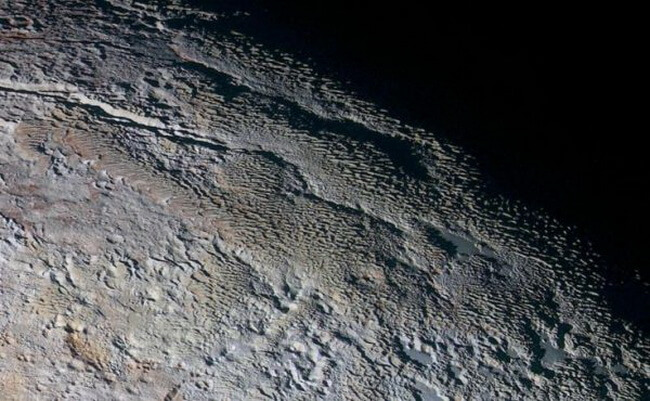- Get link
- X
- Other Apps
- Get link
- X
- Other Apps

It took almost a decade for NASA's New Horizons aerospace agency to fly through almost the entire Solar System and reach the orbit of the dwarf planet Pluto, where he collected invaluable new scientific data and found that on the surface of this tiny world there are giant 500-meter "Ice towers."
Interest for scientists this find is primarily because this phenomenon has never been found anywhere else in the solar system except the Earth. Analysis of the data obtained from the spacecraft "New horizons" indicates that these "towers" are the result of various atmospheric processes of a dwarf planet.
Perfectly discernible, as if cut by a blade, the surface of the planet in the above image is a part of the Tartarus Dorsa mountain range, over which the "New horizons" probe flew in 2015. In fact, these "cuts" are calgaspores - snow pyramids, which, as a rule, occur only in the highlands of the tropics and subtropics on Earth. On Pluto they take the form of high-rise 500-meter ice towers, which from the height look like blades, usually directed towards the Sun.

On Earth, these snow pyramids are also called "penitent snows" (from the Spanish nieves penitentes). They got this name because of their form, which reminds a penitent ("panitentes") with a bowed head and a bowed back. Thanks to the research of John Moores from York University in Canada, we now know that such peculiar formations can appear not only on Earth.

Kalgaspory in the desert Attacks. Chile
When NASA first analyzed the images of the towers obtained from the probe "New Horizons", the scientists at once did not guess what could explain such an unusual texture of the surface, and simply described it as "complex and mysterious blue-gray patterns with a reddish tint of material between the crests ". The reason for the lack of an original analogy is quite understandable, given that the height of the ice towers on Pluto reaches 500 meters, while on Earth such formations are a hundred times lower and the maximum reach 5-6 meters. Nevertheless, when Moores and his team conducted several computer simulations of the atmospheric state of Pluto, the simulations reproduced the Calgaspores exactly as they were seen by the New Horizons apparatus. According to the researchers, this is what can help us understand why we could not see anywhere else in the solar system.
"The identification of terrain unevenness of Tartarus Dorsa as calgaspores may indicate that the atmosphere of a dwarf planet is suitable for the appearance of such formations, which in turn could explain the fact that we have never before seen similar objects on other dwarf planets or airless ice satellites. In addition, the difference in the calgaspora scale on Earth and Pluto can be explained by the significant difference in the environment, "says Moores.
In the case of Pluto, the temperature here is much lower than on Earth, and the atmosphere itself is much thinner, but nevertheless the same physical and chemical principles participate in the formation of the Calgasporas themselves. These formations are formed under the influence of erosion, in which ice is sublimated in very cold conditions, that is, turns into water vapor at once, and does not melt, turning first into a liquid. The Calgasporas on Pluto consist mainly of methane and nitrogen, rather than water. And yet, despite its scale, the process of sublimation is exactly the same as on the Earth.
"Such giant dimensions can be described from the point of view of the same theory that explains the principle of the formation of these formations on Earth," Murs continues.
"In fact, we were able to identify them as calgaspores by analyzing their size, the distance between each of these formations, and their age. All three of these aspects are gathered in the general part of the proof that we have Calgaspores in front of us. "
Previously, scientists have already suggested that the satellite of Jupiter, Europe, may also have Calgaspores, but the discovery on Pluto was the first ever evidence that such formations can appear not only on Earth. Now that we know that Pluto also has such features, the computer models used, according to scientists, can help in finding similar entities on other worlds, both near and far.
"Our ground-based models for searching for calgaspor hint at the fact that we can find similar formations not only in our solar system, but also in other systems where the conditions are right for them," the scientist summed up.
The article is based on materials .
- Get link
- X
- Other Apps
Comments
Post a Comment